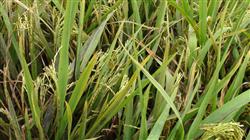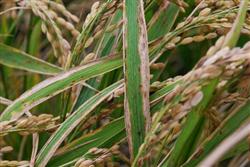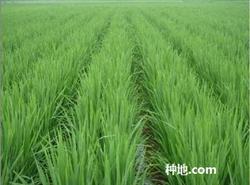neck blast Learn more about neck blast
-
How to control rice panicle blast? When is the best time to apply? How to judge?

According to the recent field monitoring results of rice blast rural monitoring networks in Heilongjiang Province, combined with comprehensive analysis of rice planting varieties, resistance, field growth, cultivation management and meteorological conditions, it is predicted that there is a risk of recurrence of rice panicle blast in Heilongjiang Province this year. that
2020-11-09 water rice panicle neck blast how control best application time yes -
How to control rice panicle neck blast caused by white panicle or deflated grain

How to control rice panicle neck blast caused by white panicle or deflated grain
2018-07-14 -
Rice blast affects rice quality how to control rice blast

Rice blast affects rice quality how to control rice blast
2018-07-14 -
Occurrence and Control of main Rice Diseases and pests in Gejiu City

1. Rice planthopper 1. damage characteristics: Rice planthopper, also known as white mosquito, is a migratory pest with the characteristics of long-distance migration and outbreak. The common ones are gray planthopper and white-backed planthopper. It occurs in the rice area of the city, mainly harming rice, followed by wheat and corn, but also parasitic on grass and other Gramineae weeds. The adults and nymphs clustered to suck the sap on the base and leaves of the rice clump, and the injured part showed a long brown spot. In severe cases, the lower stem blackened and the whole plant withered. 2. Living habits: there are 4 generations in a year, from the end of April to the beginning of May.
2019-01-16 -
Occurrence and control of rice blast and rice planthopper

First, the occurrence of rice blast: Rice leaf blast has appeared in Helan, Qingtongxia and other places. The initial period is June 13, about 10 days earlier than last year. Especially after the rainfall on July 7 and 12, the humidity in the field is relatively high, which is very beneficial to the development of leaf blast. The average rate of disease fields in the recent general survey of Qingtongxia is 16.7%.
2018-09-13 -
Rice disease

1. Rice blast (1) damage characteristics: Rice blast, also known as rice fever, commonly known as fire blast, hanging head blast, neck-choking blast and so on, is one of the most popular and harmful fungal diseases in the world, which mainly harms the aboveground part of the host plant. Due to the different damage period and position, it can be divided into seedling blast, leaf blast, ear neck blast, branch blast, grain blast and so on. The host range is many kinds of Gramineae plants, such as rice, wheat, horse tang and so on. Magnaporthe grisea overwintered mainly on diseased rice straw and was infected in rice field in the second year. The spread of bacteria mainly depends on the wind.
2019-01-16 -
Common Rice Diseases and their Control

In the whole growth period of rice, the common diseases are rice blast, bacterial leaf spot, bacterial blight, sheath blight, rice false smut and so on. The main results are as follows: (1) Rice blast can occur from seedling to heading. According to the symptoms of the disease in different growth stages and different parts, rice blast can be divided into seedling rice blast, leaf rice blast, node rice blast, panicle rice blast and grain rice blast. 1. The main symptoms (1) seedling rice blast: the diseased seedlings turn gray-black at the base of the stem near the soil surface, and the upper part is reddish brown, which makes the whole seedling curl and die. (2) Leaf rice blast:
2019-01-16 -
The latest course of techniques and methods for Prevention and Control of Rice blast in Rice planting

Rice blast is mainly divided into leaf blast and panicle and neck blast, is one of the important rice diseases, can cause a substantial reduction in yield, serious yield reduction of 40% to 50%, or even no grain harvest. 20% tricyclazole wettable powder 100 g / m mu or 75% tricyclazole wettable powder for prevention and control of leaf rice blast
2020-11-10 The latest rice planting rice blast control technology methods tutorials -
How to control the three major diseases of rice?

How to control the three major diseases of rice? Please introduce the control methods of the three major rice diseases can refer to the following methods for control: 1. Rice blast (1) Leaf blast: dark green, nearly round or oval spot, followed by a slight tip at both ends; usually when there are acute spots or disease centers, especially when nitrogen fertilizer is applied.
2018-07-18 -
How to control diseases and insect pests in rice?

How to control rice diseases and insect pests? What technology can learn from rice pest control methods: first, rice black sclerotia stem rot rice stem base of a fungal disease, also known as rice stem rot or micrococcosis. The pathogens are Aspergillus globulus and Aspergillus oryzae. Have a disposition.
2018-09-09 -
Control methods of Rice Diseases and insect pests

Control methods of Rice Diseases and insect pests
2019-03-04 -
How does grain crop rice get white ear disease to do? When will it happen? How did it happen? How to prevent it? What kind of medicine can be cured?

Rice white panicle disease is a common disease after heading, which occurs in all planting areas, and this disease will seriously affect the yield and reduce the benefit, so during the planting period, we must strengthen the management technology, then what to do if rice gets white panicle disease? When will it happen?
2020-11-09 Food crops rice get white ear disease what to do what? -
What are the common diseases of rice in cash crops? What kind of medicine should I take? How to prevent and cure it?

Rice is not only a kind of herbaceous rice, but also the most important and oldest kind of grain in rice. It belongs to direct cash crops. What are the common diseases of rice? What kind of medicine should I take? How to prevent and cure it? Let's learn more about it. During the whole growth period of rice
2020-11-09 Cash crops rice common diseases there which what -
Prevention and control techniques of rice blast in rice planting

Prevention and control techniques of rice blast in rice planting
2018-07-01 -
The latest control of common diseases in rice

1. Rice blast, also known as rice fever, can be divided into seedling blast, leaf blast, ear neck blast, branch blast, grain blast and so on. Seedling plague: the base is gray-black, the upper part turns brown, curls up and dies, and a large number of gray-black mildew layers are produced in the disease part when the humidity is high.
2020-11-10 The latest rice common disease control rice blast also known as rice -
Control of common diseases in rice

Control of common diseases in rice
2018-07-01 -
Plateau Japonica No. 1 (Rice)

The main results are as follows: (1) Variety source: it is an alpine japonica rice variety, which was bred by seed Station of Yanyuan County, Liangshan Prefecture in 1978 from the intermediate material "7801-10Mui 2mi 39". (2) characteristics: the strain has compact plant type, raised flag leaves, green leaves and light green internodes, strong cold tolerance at seedling stage, strong growth, strong tillering ability and good color conversion in the later stage. The plant height is 90 cm and the whole growth period is 185 days, which is 4-7 days later than that of the control japonica 9. The ear is 17 cm long and the number of grains is 1.
2019-01-16 -
Ganzaoxian 43 (rice)

Ganzaoxian 43 (original code 91-136) is a new early indica rice variety bred by cross breeding in Nongken School of Jiangxi Province. The whole growth period is 110 days. The plant height is 82cm, the tillering ability is strong, the effective panicle per mu is 260 000, the panicle rate is 73%, the panicle length is 19cm, the total grain per panicle is 63, the seed setting rate is 75%, and the 1000-grain weight is 25g. Brown rice rate 82.5%, rice length/width ratio 2.8. Natural induction identification of rice blast area: seedling blast 2, leaf blast 3, panicle neck blast 0. 199
2019-01-16 -
Diyou 151 (Rice)

The main results are as follows: (1) Variety source: it is a hybrid medium-can medium-maturing combination made by Digu A / Jianghui 151 (Gui 630/IB9361-4-3-2) in Jiangyou City seed Company. (2) characteristics: the growth period is 142 days, the plant height is 104 cm, the tillering ability is strong, the seedling stage grows vigorously, and the color is adjusted smoothly in the later stage. The ability of regeneration is strong. The leaf blast and neck blast were 0-3 grade, and the antibiotic rice blast was strong. 17 per mu. 60 thousand ears, 144 grains per ear, and the seed setting rate is 84. 8%, 1000-grain weight 27. 43 grams. Rough
2019-01-16 -
Fujiguang (Rice)

Yield performance the average hectare yield of 1995-1996 identification test was 8132.6 kg, which was 8.0% higher than that of the control variety Dongnong 416, and the average hectare yield of non-site identification test in 1996 was 8073.9 kg. The average yield was 6.8% higher than that of the control variety Dongnong 416. Japonica rice with characteristic characteristics, the number of growth days is about 132 ℃, and the active accumulated temperature is 2500 min. The plant height is 90 cm, the ear length is 18 cm, the number of grains per ear is about 80, and the 1000-grain weight is 2.
2019-01-16
